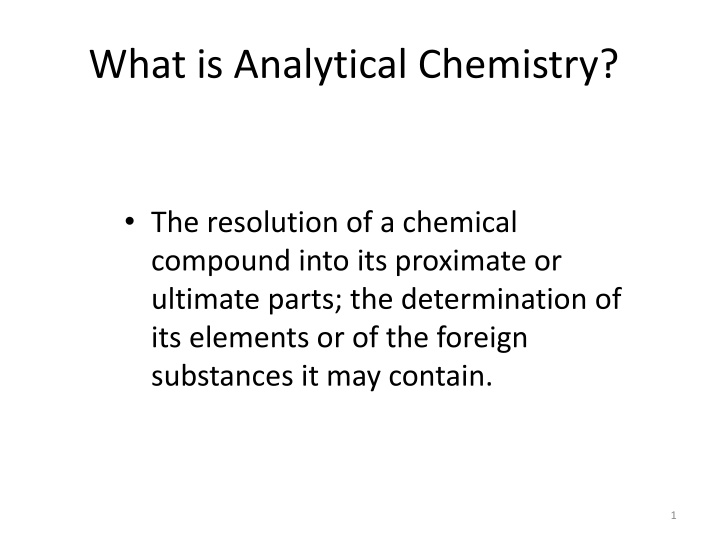
Analytical Chemistry: Unveiling the Components of Chemical Compounds
Analytical chemistry focuses on resolving chemical compounds into their elemental parts, determining elements present, and identifying foreign substances. It encompasses qualitative and quantitative analysis, as well as applications in various fields like forensic science, medicine, and biochemistry.
Download Presentation

Please find below an Image/Link to download the presentation.
The content on the website is provided AS IS for your information and personal use only. It may not be sold, licensed, or shared on other websites without obtaining consent from the author. If you encounter any issues during the download, it is possible that the publisher has removed the file from their server.
You are allowed to download the files provided on this website for personal or commercial use, subject to the condition that they are used lawfully. All files are the property of their respective owners.
The content on the website is provided AS IS for your information and personal use only. It may not be sold, licensed, or shared on other websites without obtaining consent from the author.
E N D
Presentation Transcript
What is Analytical Chemistry? The resolution of a chemical compound into its proximate or ultimate parts; the determination of its elements or of the foreign substances it may contain. 1
Introduction to Chemical Analysis Chemical analysis includes any aspect of the chemical characterization of a sample material. Analytical Chemistry? Science of Chemical Measurements 2
Areas of Chemical Analysis and Questions They Answer Quantitation: How much of substance X is in the sample? Detection: Does the sample contain substance X? Identification: What is the identity of the substance in the sample? Separation: How can the species of interest be separated from the sample matrix for better quantitation and identification? 3
What is Analytical Chemistry? Qualitative Analysis Quantitative Analysis 4
What is Analytical Chemistry? Qualitative analysis The determination of the components of an unknown sample. Organic spectroscopy 5
Quantitative analysis The determination of the quantity of the components in a sample. Classical methods 6
What is Analytical Chemistry? Forensic Science Medicine Physics Analytical Science Biochemistry Materials Science Physical Chemistry Organic Chemistry 7
Titration Titration is a procedure for determining the concentration of a solution by allowing a carefully measured volume to react with a standard solution of another substance, whose concentration is known. By finding the volume of the standard solution that reacts with the measured volume of the first solution, the cconcentration of the first solution can be calculated. 8
equivalent point The point that all reactants are consumed, Stoichiometric mol numbers of both reactants are equal. an indicator a compound that change its color around equivalent point. such as phenolphthalein, is colorless in acidic solution but turns pink in basic solution. 9
Calculations in the volumetric titrimetry Calculations in the volumetric titrimetry aA + bB cC + dD a mol A react with b mol B When A is a standard (titrant) the volume of A used in the titration and its molarity can be used to calculate the mol number of B 12
Example: A 25.0 mL sample of vinegar (dilute acetic acid, ) is titrated and found to react with 94.7 mL of 0.200 M NaOH. What is the molarity of the acetic acid solution? 13
The pH Scale The pH is defined as the negative logarithm in base 10, of the hydronium ion concentration pH = - log[H3O+] The pOH is defined as the negative logarithm in base 10, of the hydroxyl ion concentration pOH = - log[OH-] 14
pH of an acidic solution < 7.00 pH of a neutral solution = 7.00 pH of a basic solution > 7.00 15
Buffer solution is a solution whose pH changes only very slightly upon the addition of small of either an acid or a base. Buffer solutions contain a weak acid and its conjugate base ( its salt) or a weak base and its conjugate acid ( its salt). 18
Buffers A buffered solution resists changes in pH when acids or bases are added or when dilution occurs. 21
The buffer is a mixture of an acid and its conjugate base. There must be comparable amounts of the conjugate acid and base (say, within a factor of 10) to exert significant buffering. 22
The relationship between Ka and Kb for a conjugate acid-base pair: Ka*Kb = Kw. Weak is conjugate to weak. The conjugate base of a weak acid is a weak base and vice verse. 25
Weak acid equilibria Why is the ortho isomer 30 times more acidic than the para isomer? The product of the acid dissociation reaction forms a strong, internal hydrogen bond, that drives the reaction forward. 26
Calculate the pH of a weak acid For any respectable weak acid, [H+] from HA will be much greater than [H+] from H2O If dissociation of HA is much greater than H2O dissociation, [A-] >>[OH-] Example: Calculation the pH of 0.0500 M o-hydroxybenzoic acid solution. The Ka = 1.0 x 10-3. Solution: plug into the above equation with F= 0.0500 and Ka = 1.0 x 10-3 27
The fraction of dissociation,, is defined as the fraction of the acid in the form A Fraction of dissociation of a weak electrolyte increases as electrolyte is diluted. The stronger acid is more dissociated than the weaker acid at all concentrations. Weak electrolytes (compounds that are only partially dissociated) dissociate more as they are diluted. 28
Weak base equilibria Calling the formal concentration of base F (= [B] + [BH+]), Notice that approximation in the last equation looks like a weak-acid problem, except that now x = [OH ]. 29






















